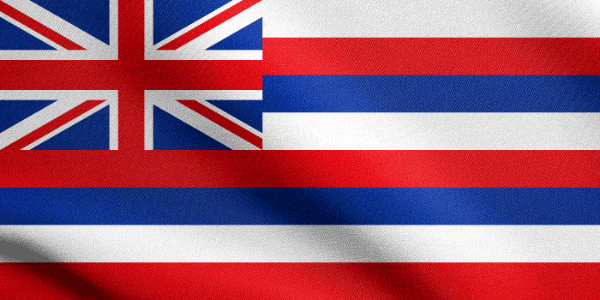Hawaii
State abbreviation/Postal code: Hawaii/HI Governor: David Ige, D (to Dec. 2018) Lieut. Governor: Shan Tsutsui (to Dec. 2018) Senators: Mazie Hirono (D) (to Jan. 2019); Brian Schatz, D (to Dec. 2023) Historical biographies of Congressional members Atty. General: Doug Chin, D (to 2018) Organized as territory: 1900 Entered Union (rank): Aug. 21, 1959 (50) Motto: Ua Mau Ke Ea O Ka Aina I Ka Pono (The life of the land is perpetuated in righteousness)
Nickname: Aloha State (1959) Origin of name: Uncertain. The islands may have been named by Hawaii Loa, their traditional discoverer. Or they may have been named after Hawaii or Hawaiki, the traditional home of the Polynesians. 10 largest cities1 (2010): Honolulu, 374,701; Ewa, 279,683; Koolaupoko, 121,180; East Honolulu, 49,914; Pearl City, 47,698; Hilo, 43,263; Waipahu, 38,216; Kaneohe, 34,597; North Kona, 33,155; Mililani Town, 27,629. Land area: 6,423 sq mi. (16,637 sq km) Geographic center: Between islands of Hawaii and Maui Number of counties: 5 (Kalawao non-functioning) Largest county by population and area: Honolulu, 974,990 (2012); Hawaii, 4,028 sq mi. State forests: 19 natural area reserves (over 109,000 ac.) State park: 52 (25,000 ac.) Residents: Hawaiian, also kamaaina (native-born nonethnic Hawaiian), malihini (newcomer) 2015 resident population: 1,431,603 2010 resident census population (rank): 1,360,301 (40). Male: 681,243 (50.1%); Female: 679,058 (49.9%). White: 336,599 (24.7%); Black: 21,424 (1.6%); American Indian: 4,164 (0.3%); Asian: 525,078 (38.6%); Native Hawaiian and Other Pacific Islander: 135,422 (10.0%); Other race: 16,985 (1.3%); Two or more races: 320,629 (23.6%); Hispanic/Latino: 120,842 (8.9%). 2010 population 18 and over: 1,056,483; 65 and over: 195,138 (14.3%); median age: 38.6. 1. Census Designated Places. |
First settled by Polynesians sailing from other Pacific islands between A.D. 300 and 600, Hawaii was visited in 1778 by British captain James Cook, who called the group the Sandwich Islands.
Hawaii was a native kingdom throughout most of the 19th century, when the expansion of the sugar industry (pineapple came after 1898) meant increasing U.S. business and political involvement. In 1893, Queen Liliuokalani was deposed, and a year later the Republic of Hawaii was established with Sanford B. Dole as president. Following annexation (1898), Hawaii became a U.S. territory in 1900 and finally a state in 1959.
The Japanese attack on the naval base at Pearl Harbor on Dec. 7, 1941, was directly responsible for U.S. entry into World War II.
Hawaii, 2,397 mi west-southwest of San Francisco, is a 1,523-mile chain of islets and eight main islands—Hawaii, Kahoolawe, Maui, Lanai, Molokai, Oahu, Kauai, and Niihau. The Northwestern Hawaiian Islands, other than Midway, are administratively part of Hawaii.
The temperature is mild, and cane sugar, pineapple, and flowers and nursery products are the chief products. Hawaii also grows coffee beans, bananas, and macadamia nuts. The tourist business is Hawaii's largest source of outside income.
Hawaii's highest peak is Mauna Kea (13,796 ft). Mauna Loa (13,679 ft) is the largest volcanic mountain in the world by volume.
Among the major points of interest are Hawaii Volcanoes National Park (Hawaii), Haleakala National Park (Maui), Puuhonua o Honaunau National Historical Park (Hawaii), Polynesian Cultural Center (Oahu), the USS Arizona and USS Missouri Memorial at Pearl Harbor, The National Memorial Cemetery of the Pacific (Oahu), and Iolani Palace (the only royal palace in the U.S.), Bishop Museum, and Waikiki Beach (all in Honolulu).
In 2008, Hawaii-born Barack Obama was elected president of the United States.
See more on Hawaii:
Encyclopedia: Hawaii
Encyclopedia: Geography
Encyclopedia: Economy
Encyclopedia: Government
Encyclopedia: History
Monthly Temperature Extremes
All U.S. States: Geography & Climate
Printable Outline Maps
Record Highest Temperatures
Record Lowest Temperatures
Highest, Lowest, and Mean Elevations
Land and Water Area
All U.S. States: Population & Economy
Historical Population Statistics, 1790–Present
Per Capita Personal Income
Minimum Wage Rates
State Taxes
Federal Government Expenditure
Percent of People in Poverty
Births and Birth Rates
Homeownership
Percentage of Uninsured by State
All U.S. States: Society & Culture:
Most Livable States
Healthiest States
Most Dangerous States
Smartest States
Crime Index
Residency Requirements for Voting
Compulsory School Attendance Laws
Driving Laws
National Public Radio Stations
Selected famous natives and residents:
- Salevaa Atisanoe (Konishiki) sumo wrestler;
- George Ariyoshi first Japanese-American elected governor;
- Angela Perez Baraquio Miss America (2001);
- Tia Carrere singer, actress;
- Steve Case business executive;
- Father Damien priest;
- Hiram L. Fong first Chinese-American senator;
- Don Ho entertainer;
- Daniel Ken Inouye congressman;
- Kaahumanu Hawaiian queen;
- Duke Paoa Kahanamoku Olympic swimming champion;
- Kamehameha I first Hawaiian king;
- Kamehameha V last of the dynasty;
- Liliuokalani queen, last Hawaiian monarch;
- Bette Midler singer;
- Barack Obama U.S. President;
- Ellison Onizuka astronaut;
- Chad Rowan (Akebono) sumo wrestler;
- Harold Sakata actor;
- Carolyn Suzanne Sapp Miss America (1991);
- James Shigeta actor;
- Don Stroud actor;
- John Waihee first Hawaiian elected governor;
- Michelle Wie professional golfer.


